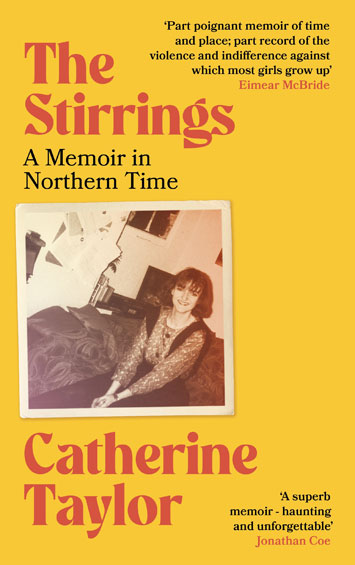The Stirrings by Catherine Taylor – Review

By Clare Jenkins
In 1977, Ian Dury released his song, ‘Reasons to be Cheerful Pt 3’. It included references to Buddy Holly, the Bolshoi Ballet, seeing Piccadilly and ‘The juice of a carrot, the smile of a parrot/A little drop of claret, anything that rocks’. To which I’d add, “Having experienced 1980s Sheffield very differently to Catherine Taylor”.
We were both in the city at that time, she at school, me on the Sheffield Star and Morning Telegraph. It was the era of Greenham Common, which I (like Taylor) visited along with coachloads of other women to hold hands around the nuclear base. The era of Barry Hines’s apocalyptic film Threads (she was a blood-stained extra). The era of cheap bus fares, the Socialist Republic of South Yorkshire, the Falklands War, Hillsborough, steelworkers’ and miners’ strikes and Margaret Thatcher. I was in the crowd outside the Cutlers Hall when she had eggs thrown at her en route for the Cutlers’ Feast. “They can’t be that hard-up if they can afford eggs,” sneered one dinner-jacketed politician.
Over-archingly in this memoir, it was the era of the Yorkshire Ripper, when women bought rape alarms and went on angry, fear-filled marches to Reclaim the Night. It’s that series of killings that scars this ‘ordinary story’ of adolescence and young womanhood.
The idea is to frame her own fractured teenage years – a family relocation from New Zealand to Sheffield, the break-up of her parents’ marriage, arguments over parental access, her mother’s transition from schoolteacher to bookshop-owner, her father’s near-fatal car crash – with the turbulence of a period in which the spectre of the Ripper stalked the North of England. He was eventually, of course, caught in Sheffield – in the lane next to Taylor’s private Girls’ High School. And he looms over her early life like a shadow on the ceiling (to copy the author’s own propensity for Gothic metaphor).
Peter Sutcliffe’s 13 murders and ‘the faces of the stalked, the assaulted, the abducted, the murdered’ heighten the sense of danger in her own life. A life where men would ‘interfere’ with themselves on public paths or sitting opposite you on trains, where older men with wine on their breath would stare at your 14-year-old breasts at parties, where transit vans ‘lurked’ alarmingly round every corner, with who knows what – or who – inside.
‘The colliding with evil,’ she writes, ‘that malignant dark star forever on our horizon, was always a mere spasm away: not preordained in life’s great lottery, but random, and terrible, terrible luck’.
After which, it’s not much of a surprise to learn that when Sutcliffe’s trial began in April 1981, it was on her birthday.
“Relentless cheerlessness”
 The book starts in Sheffield’s General Cemetery where, ‘as we slink like cats from street lamp to street lamp’, the 13-year-old Catherine and her pals pass a couple of sex workers. The cemetery church ‘rises up like a question mark: a broken, blackened fingernail’. Gang-leader Lucy, whose ‘white teeth flash momentarily, like a switchblade cutting through the semi-darkness’ dares them all to run through, dodging graves, ‘scattering as deer from an invisible hunter’. They all do, apart from Catherine, who’s too ‘frit’. After they’ve left her, ‘Their breath hangs in the chilly air like ectoplasm’. As she says in the second paragraph, ‘there is hell, and it is here’.
The book starts in Sheffield’s General Cemetery where, ‘as we slink like cats from street lamp to street lamp’, the 13-year-old Catherine and her pals pass a couple of sex workers. The cemetery church ‘rises up like a question mark: a broken, blackened fingernail’. Gang-leader Lucy, whose ‘white teeth flash momentarily, like a switchblade cutting through the semi-darkness’ dares them all to run through, dodging graves, ‘scattering as deer from an invisible hunter’. They all do, apart from Catherine, who’s too ‘frit’. After they’ve left her, ‘Their breath hangs in the chilly air like ectoplasm’. As she says in the second paragraph, ‘there is hell, and it is here’.
And that sets the tone, unleavened by any flash of humour, for what is to come. A portrayal of Sheffield and the turbulent wider world in the 80s as disturbed, disturbing and full of dread, filled with fear of imminent death from a nuclear explosion or a serial killer. A world where there’s always a ‘sour tang’ in the air. Where, ‘By late October the dark drew itself down suddenly like a blind’… Where she can’t sleep for fear of being ‘mummified in a winding sheet’. A world where even inanimate objects like a telephone receiver ‘weeps emptiness from its mouth’ and, in the rain, the red dye in her shoes ‘drained swiftly from them like blood from a frightened face’.
At 17, she was diagnosed with Graves’ Disease, a serious auto-immune condition, for which she eventually underwent (and nearly didn’t survive) a major operation. Maybe that accounts for some of the negativity? Because she can’t go to a disco without ‘the sour smell of vomit, piss and cheap lager mingled with the iron reek of blood blooming from the wrists of a girl I encountered in the toilets, opening up her unhappy veins to yet another sticky-black Saturday night’. Can’t go to work in a cutlery factory without, on the first morning, badly cutting her finger on a serrated knife. Blood, and more blood.
She doesn’t carry a suitcase, she drags it. A cat doesn’t pad sweetly along a path, it takes ‘a leisurely sh*t among the debris of the back garden, a miserable scene wreathed in mist and drizzle’. She loses her virginity in a ‘brief and jabbing congress which lasted all of a minute’, goes to university in Cardiff where she has a number of unhappy relationships. By the time she recounts an unwanted pregnancy and subsequent abortion, and the seemingly accidental death-by-sleepwalking of her flatmate Rosa, I felt almost desensitised to trauma and tragedy.
The book ends when she returns to Sheffield before starting a new life in London, where she eventually becomes a publisher at The Folio Society and deputy director of English PEN, the worldwide writers’ association.
Maybe that’s where she learnt the importance of contemporary references in memoirs – which she applies almost obsessively. The very first paragraph namechecks peanut butter sandwiches, Kit Kat, and Siouxsie and The Banshees, closely followed by references to TV’s Sapphire and Steel and Dallas, Jackie and Smash Hits magazines, Twix, Opal Fruits and Spangles. The text throughout is overburdened with brand names, popular cultural references and contemporary events: Nivea Crème and Ambre Solaire, Derek Jarman’s 1978 film Jubilee, prawn cocktail-flavoured crisps, ‘sickly sweet, cherry-flavoured lip gloss which came free with Mates magazine’, ABBA’s ‘Knowing Me, Knowing You’. Which, unsurprisingly, she sang ‘mournfully’.
Ultimately, while it’s exhaustively researched and undoubtedly skilfully written, its relentless cheerlessness left me feeling immensely grateful for my own Sheffield-in-the-1980s memories, and for all the funny, feisty, formidable women I knew and worked with during that decade.
‘The Stirrings: A Memoir in Northern Time’ by Catherine Taylor is published by Weidenfeld & Nicolson









